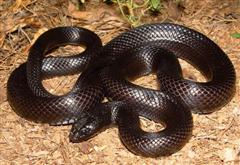Kingsnake - Common
Common King Snake Scientific Name: Lampropeltis getula
Sat, 19th July, 2025 - 2:34 am GMT
Sponsor Ads:

Alternative Name
Common King Snake Scientific Name: Lampropeltis getulaBasic Info
There are many color variations and patterns for this kind of snake, though bands are common. The colors can include combinations of black, brown, cream, white and pale yellow depending on their habitat. There are also some minor variants of what the snake's bellies may look like. Some may have pure black bellies while others may only be mostly back. The average length for this snake is between 36 and 48 inches from nose to tail.
Health
Breeding The Breeding season for the Common Kingsnake goes from March to June, with clutches of 4 to 20 eggs being laid between the months of May and August. The incubation period can last from 41 to 87 days. The average hatchling, measuring between 8 and 13 inches when hatched, will take about three years to reach maturity.Habitat
Marshes, deserts, grasslands, forests and woodlands are all places where this creature lives. Near rocky outcrops or clusters of plants and under rocks, logs or other debris, are favorite hiding places.Behavior
The Common Kingsnake is generally considered to be a good pet to have by snake lovers. There are a number of subspecies of the Common Kingsnake, including the Arizona Desert Kingsnake, the Black Kingsnake of Mexico, the Yuma Kingsnake, and the California Kingsnake. They also should not be confused with Mountain Kingsnakes or Mexican Kingsnakes, which are two separate types of snake. The habitats that it has adapted to are also fairly diverse. The Kingsnake got its name because of the fact that aggressive and venomous snakes make up part of its diet, including the Rattlesnake, Copperhead and Coral Snakes. The venom is not a concern, since the Common Kingsnake is immune. One final but interesting note about the Common Kingsnake is its defensive posturing. If it feels threatened, it will hiss and shake the end of its tail (much like a Rattlesnake) before finally lashing out and striking at the aggressor. If it is attacked, the Common Kingsnake will musk its foe in the hopes of discouraging further aggression.Origin
North AmericaHistory
N/ACommon Foods
feeds on lizards, birds, snakes, eggs, frogs, lizards and small mammalsSponsor Ads:
Measured with a micrometer. Marked with chalk. Cut with an axe. -- Unknown
Kingsnake - Common
Coded by: BGID® | ALL RIGHTS RESERVED Copyright © 2000-2025
Disclaimer | Privacy | Report Errors / Contact | Credits


 Why haven't we as a collective earth met with aliens yet?
Why haven't we as a collective earth met with aliens yet?  World EcoSystem - Biodiversity Changes - Who is on board and who isn
World EcoSystem - Biodiversity Changes - Who is on board and who isn  Homosexual behavior stems from the mind or genetics?
Homosexual behavior stems from the mind or genetics?  The Best Text Adventure You Will Ever Play! The official site:
The Best Text Adventure You Will Ever Play! The official site:  Mouthwash - Mouthrinse - Mouth Sores - Healing Infections - Gingivitis
Mouthwash - Mouthrinse - Mouth Sores - Healing Infections - Gingivitis  Treatment for Depression
Treatment for Depression  Ultra radical and violent Islamist group that even rivals Al Qaeda
Ultra radical and violent Islamist group that even rivals Al Qaeda  An idea to have teachers who want to carry guns to school undergo some level of police training will be left up to local school districts and police departments.
An idea to have teachers who want to carry guns to school undergo some level of police training will be left up to local school districts and police departments.